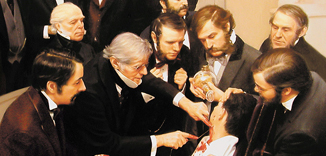Paul S. Russell, MD Museum of Medical History and Innovation
Creating the Ether Dome Painting
Discover how physicians at Massachusetts General Hospital worked with painters Warren and Lucia Prosperi to immortalize the groundbreaking surgery in the famous Ether Dome painting.

In the autumn of 1846, three men made history inside the surgical amphitheater in Massachusetts General Hospital's Bulfinch Building. Dentist William T.G. Morton administered ether to a patient named Edward G. Abbott, who had a tumor of the jaw. When Abbott slipped into unconsciousness, surgeon John Collins Warren, MD, bent over his patient and began removing the tumor.
To the audience's amazement, Abbott never cried out in pain during the procedure. For the first time in public, a physician had performed a surgical procedure using ether as an anesthetic. The event ushered in the era of pain-free surgery, and the hospital's amphitheater would be known forever as the Ether Dome.
The event was captured at the time in photographs and paintings. In 2000, Mass General's service chiefs and physicians commissioned painters Warren and Lucia Prosperi to create the Ether Dome painting. A gift to the hospital, the painting immortalizes the groundbreaking surgery in the very room where the drama had unfolded.
The Artists Shoot for Authenticity
To ensure a realistic outcome, the Prosperis restaged the surgery at the Ether Dome with Mass General physicians assuming the roles of the original participants. Warren Zapol, MD, chief of Anesthesia and Critical Care, starred as Dr. Morton, while Philip Kistler, MD, director of the Mass General Stroke Unit, played Dr. Warren.
Members of the Emerson College Department of Performing Arts outfitted the actors with replicas of 19th century pocket watches, monocles, cravats and frock coats. The set even featured the same maroon velvet upholstered chair in which Abbott sat over 150 years earlier.
As camera bulbs flashed, the Prosperis directed the actors to strike various poses and imitate the facial expressions of their predecessors. A few physicians-turned-actors interrupted to protest that the incision in the patient's plastic and latex tumor was "too neat, too clean." In response, the makeup team dutifully applied more fake blood.
Unveiling a Painting That Connects the Past with the Future
From the dozens of photos they snapped, the Prosperis created 20 miniature portraits. The artists referred to these shots closely as they painted, morphing the features of the modern-day models into the faces of their 19th century counterparts. Nearly a year later, the hospital staff introduced the 10-by-7 foot mural to the medical community during the hospital’s annual Ether Day celebration.
Recreating the Ether Dome spectacle left a lasting impression on at least one Mass General service chief. Dr. Zapol (i.e. Dr. Morton) spent the day wearing a glued-on mustache and muttonchops that took makeup artists more than two hours to apply. To Dr. Zapol, any discomfort he experienced was a small price to pay to become part of history.
"Doing this was wonderful," he said. "[Drs. Morton and Warren] were remaking the world. As I was playing Morton, I kept thinking, 'The guy was only 25, just a kid when he did this. He had chutzpah, he was an impresario.' That's what I was trying to convey."
